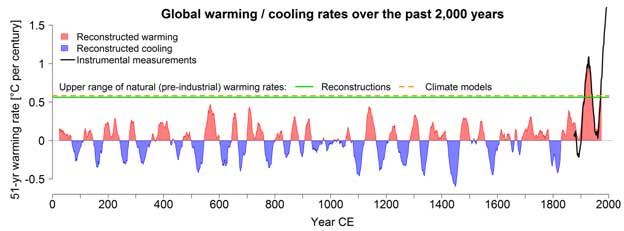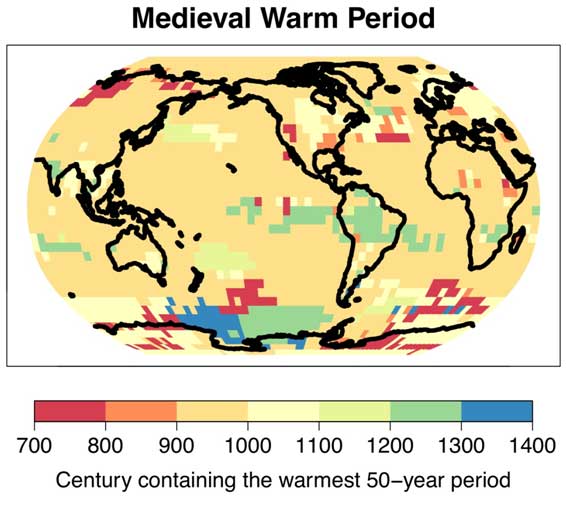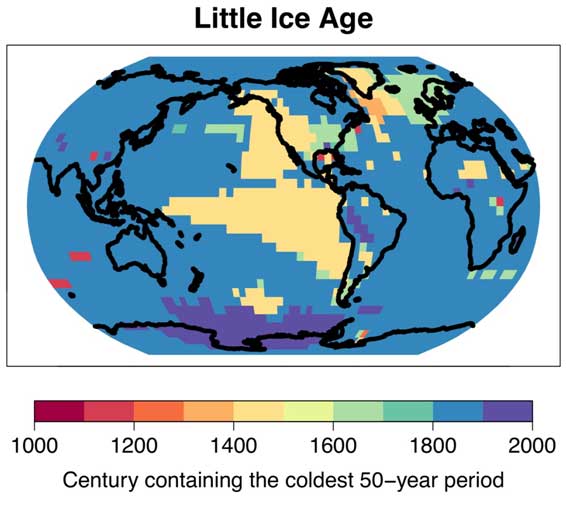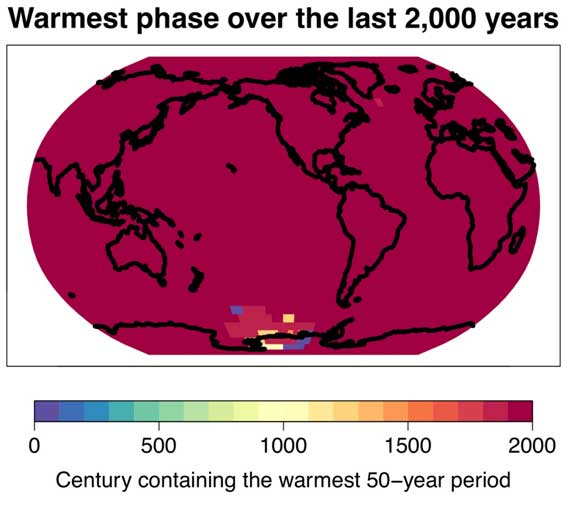
Global mean warming / cooling rates over the last 2,000 years. In red are the periods (each across 51 years) in which the reconstructed temperatures increased. Global temperatures decreased in the periods in blue. The green line shows that the maximum expected warming rate without anthropogenic influence is just under 0.6 degrees per century. Climate models (dashed orange line) are able to simulate this natural upper limit very well. At more than 1.7 degrees per century, the current rate of warming is significantly higher than the expected natural rate of warming, and higher than values for every previous century. Instrumental measurements since 1850 (in black) confirm these figures. © University of Bern

The warm period known as the “Medieval Warm Period” in Europe and North America was not a global phenomenon; the warmest 50-year period between the years 700 and 1400 occurred at different times in different regions. © University of Bern

The cold period known as the “Little Ice Age” in Europe and North America was not a global phenomenon; the coldest 50-year period of the last millennium occurred at different times in different regions. © University of Bern

Modern global warming is a global phenomenon; the warmest 50-year period of the last 2000 years occurred on more than 98% of the earth’s surface in the 20th century. © University of Bern
In contrast to pre-industrial climate fluctuations, current, anthropogenic climate change is occurring across the whole world at the same time, finds new studies. Moreover, the speed of global warming is higher than it has been in at least 2,000 years.
Many people have a clear picture of the “Little Ice Age” (from approx. 1300 to 1850). It’s characterized by paintings showing people skating on Dutch canals and glaciers advancing far into the alpine valleys. That it was extraordinarily cool in Europe for several centuries is proven by a large number of temperature reconstructions using tree rings, for example, not just by historical paintings.
There are also similar reconstructions for North America. It was assumed that the “Little Ice Age” and the similarly famous “Medieval Warm Period” (approx. 700-1400) were global phenomena.
Now an international group of scientists led by Raphael Neukom of the Oeschger Center for Climate Change Research at the University of Bern is painting a very different picture of these alleged global climate fluctuations.
In a study, “No evidence for globally coherent warm and cold periods over the preindustrial Common Era” by Raphael Neukom, Nathan Steiger, Juan José Gómez-Navarro, Jianghao Wang and Johannes P. Werner (Nature, 571, July 24, 2019), and in a supplementary publication, “Consistent multidecadal variability in global temperature reconstructions and simulations over the Common Era” (Nature Geoscience, 12, July 24, 2019), the scientists show that there is no evidence that there were uniform warm and cold periods across the globe over the last 2,000 years.
Climate fluctuations in the past varied from region to region
The “No evidence for … Common Era” study said:
Earth’s climate history is often understood by breaking it down into constituent climatic epochs. Over the Common Era (the past 2,000 years) these epochs, such as the Little Ice Age, have been characterized as having occurred at the same time across extensive spatial scales. Although the rapid global warming seen in observations over the past 150 years does show nearly global coherence, the spatiotemporal coherence of climate epochs earlier in the Common Era has yet to be robustly tested. Here we use global palaeoclimate reconstructions for the past 2,000 years, and find no evidence for preindustrial globally coherent cold and warm epochs. In particular, we find that the coldest epoch of the last millennium — the putative Little Ice Age — is most likely to have experienced the coldest temperatures during the fifteenth century in the central and eastern Pacific Ocean, during the seventeenth century in northwestern Europe and southeastern North America, and during the mid-nineteenth century over most of the remaining regions. Furthermore, the spatial coherence that does exist over the preindustrial Common Era is consistent with the spatial coherence of stochastic climatic variability. This lack of spatiotemporal coherence indicates that preindustrial forcing was not sufficient to produce globally synchronous extreme temperatures at multidecadal and centennial timescales. By contrast, we find that the warmest period of the past two millennia occurred during the twentieth century for more than 98 per cent of the globe. This provides strong evidence that anthropogenic global warming is not only unparalleled in terms of absolute temperatures5, but also unprecedented in spatial consistency within the context of the past 2,000 years.
The “Consistent multidecadal variability … over the Common Era” study said:
Multidecadal surface temperature changes may be forced by natural as well as anthropogenic factors, or arise unforced from the climate system. Distinguishing these factors is essential for estimating sensitivity to multiple climatic forcings and the amplitude of the unforced variability. Here we present 2,000-year-long global mean temperature reconstructions using seven different statistical methods that draw from a global collection of temperature-sensitive palaeoclimate records. Our reconstructions display synchronous multidecadal temperature fluctuations that are coherent with one another and with fully forced millennial model simulations from the Coupled Model Intercomparison Project Phase 5 across the Common Era. A substantial portion of pre-industrial (1300-1800 ce) variability at multidecadal timescales is attributed to volcanic aerosol forcing. Reconstructions and simulations qualitatively agree on the amplitude of the unforced global mean multidecadal temperature variability, thereby increasing confidence in future projections of climate change on these timescales. The largest warming trends at timescales of 20 years and longer occur during the second half of the twentieth century, highlighting the unusual character of the warming in recent decades.
“It’s true that during the Little Ice Age it was generally colder across the whole world,” explains Raphael Neukom, “but not everywhere at the same time. The peak periods of pre-industrial warm and cold periods occurred at different times in different places.”
According to the climate scientist from Bern, the now-debunked hypothesis of climate phases occurring at the same time across the globe came about because of an impression that is defined by the climate history of Europe and North America.
In the absence of data from other parts of the earth, this notion was applied to the whole planet, raising expectations that relatively cold or warm periods throughout the last 2,000 years were globally synchronous phenomena. But it has now been shown that this was not the case.
The authors of the study in Nature see the explanation for that as being that regional climates in pre-industrial times were primarily influenced by random fluctuations within the climate systems themselves.
External factors such as volcanic eruptions or solar activity were not intense enough to cause markedly warm or cold temperatures across the whole world for decades, or even centuries.
The researchers relied on a database from the international research consortium PAGES, which provides a comprehensive overview of climate data from the last 2,000 years, for their investigation of five pre-industrial climate epochs. In addition to tree rings, it also includes data from ice cores, lake sediments and corals.
To really put the results to the test, the scientists analyzed these data sets using six different statistical models – more than ever before. This allowed for the calculation of the probability of extremely warm or cold decades and centuries, and not just the calculation of absolute temperatures.
The result was that no globally coherent picture emerged during the periods being investigated.
“The minimum and maximum temperatures were different in different areas,” says Raphael Neukom. So thermal extremes across the world cannot be inferred from regional temperature phenomena like the oft-mentioned “Medieval Warm Period” in Europe and North America.
The current warm period is happening across the world for the first time
The results look very different for recent history. Both studies show that the warmest period of the last 2,000 years was most likely in the 20th century.
The scientists also show that this was the case for more than 98 percent of the surface of the earth. This shows – once again – that modern climate change cannot be explained by random fluctuations, but by anthropogenic emissions of CO2 and other greenhouse gases. What we didn’t know until now is that not only average global temperatures in the 20th century are higher than ever before in at least 2,000 years, but also that a warming period is now affecting the whole planet at the same time for the first time. And the speed of global warming has never been as high as it is today.











































